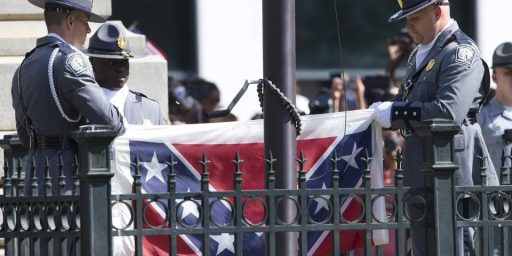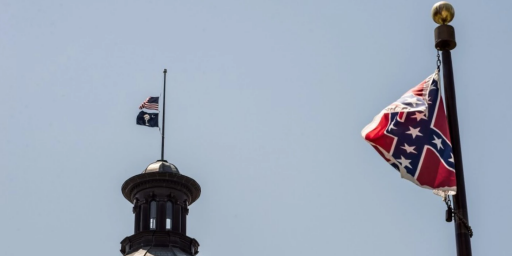Confederate Flags Removed from Alabama Capitol Grounds
Via WSFA: Confederate flags removed from Alabama Capitol grounds
Alabama Governor Robert Bentley ordered the removal of all Confederate flags from the Confederate Memorial Monument that stands on the grounds of the state Capitol, making him the first Southern governor to completely remove the flag from the state capitol.
The four flags (three national flags and one battle flag) were removed Wednesday morning by executive order. "It has become a distraction all over the country right now," the Governor said. "Off and on, it’s always been a distraction."
First, kudos to the governor for making this decision.
Second, I am truly surprised by the move and am intrigued by the speed at which the current reaction to this symbol is unfolding.
It seems as if the current debate has caused a lot of people to finally stop and realize why the battle flag is such a problematic symbol.
Also, a related story notes the history of the flag and the Alabama capitol:
April 25, 1963: The Confederate Naval Jack flag was raised over the Capitol on the day when Attorney General Robert Kennedy met Gov. George Wallace inside the Capitol. It wasn’t removed after this visit.
During this time, the American flag was flown from a flag pole on the south lawn. The Alabama flag and Confederate Naval Jack were on the dome.
So, again: here we see the direct relationship of the flag as a clear symbol of opposition to desegregation.
The timeline continues:
1975: Alvin Holmes filed suit to require the American flag be flown from the highest position. A federal district court said the Flag Code suggests, but does not require, the American flag to be flown from the highest position.
Wallace made the decision to fly the U.S. flag from the highest point. The Alabama flag was below it followed by the Confederate Naval Jack.
1976: Alvin Holmes filed a suit against Wallace and others to prohibit the flying of the Confederate flag over the Capitol. The federal district court ruled against Holmes.
1988: The NAACP, Alvin Holmes and others filed a lawsuit against Gov. Guy Hunt seeking to remove the Confederate battle flag from the State Capitol grounds. The district court again ruled against Holmes.
Late 1980s-Early 1990s: The Alabama Capitol was flying the U.S., Alabama and Confederate battle flags. All three were taken down due to a massive renovation of the capitol in the early 1990s.
Alvin Holmes and other legislators filed a third lawsuit using a different argument than the first two (1976 and 1988). They argued that an Alabama law from 1975 doesn’t allow for the flying of any flag above the Capitol other than the U.S. and Alabama flags.
Jan. 4, 1993: Circuit Judge William Gordon rules in favor of Alvin Holmes. Judge ordered Alabama law allows only the state and national flag be flown over Alabama’s capitol and enjoined the governor from raising the Confederate, or any other flag.
So, again, when one wishes to argue that the flag is a symbol of “heritage” it is important to realize what that specific heritage contains.





I was curious enough to check WIKI. The Confederate Naval Jack (presumably the second Naval jack) is a rectangular version of the Battle Flag. i.e. it’s what we picture as the Battle Flag, more so than the actual square Battle Flag.
It’s confusing that the Confederates couldn’t even agree on flags, much less conduct of the war. But, that’s what you get when you take the U. S. Constitution and rewrite it with a lot of state’s rights and libertarianism.
Talk about “A tide, in the affairs of men.”
I think of George Wallace barking out, “Segregation yesterday, segregation tomorrow, and segregration forever”. How things have changed!
But on the other hand, its been 53 years since that speech.
In related news, Hell is reported to have indeed frozen over.
@stonetools: Somewhere in my brain there is a little line, a quote I cannot pin down well enough to use confidently, that says ‘history moves by starts and jumps’. The present movement on SSM and confederate emblems fits perfectly.
Speaking of the “confederate pride” issue, I was reading a query from a northern woman who asked, nicely, if someone would explain it to her so she could get a handle on the concept. The politest response she got was “you wouldn’t understand.”
So…”confederate pride” appears to be something its proponents are either unable or unwilling to explain.
I think that timeline confuses what is being done here. I’ve wandered around the Capitol, and there is a monument to the Confederate war dead on the back side, which is the kind of thing you would see at battlefields and town squares all over the place, many, like this one, built in the 19th century. It’s large, but the capital grounds are littered with statuary, including IIRC an African-American physician who made a significant contribution to his field (OBGYN?). I wouldn’t consider this to be a conspicuous location, like the one in South Carolina, where the flag is prominent in the central entrance to the building. I participated in the South Carolina boycott in my own small way about 12 years ago, so I’m certainly persuadable on this, but I do think the flags there are part of an historical purpose that is different than the flag that flew over the dome over 20 years ago.
@PD Shaw: I agree that the monument in Alabama was a different type of display than was the case in SC. Indeed, I am surprised the governor made the move.
I posted the timeline because it underscores the ~30 years during which the flag was flown over the dome in clear opposition to desegregation.
Utterly shocking. It’s like most of America woke up and recognized the hate mongers for what they are, and decided that pretending they were anything else was stupid.
That said, I am saddened that they won’t be selling toys of the General Lee with the confederate flag on it any more — they’re just messing with history there.
Tell you what. Go build a monument to the Texan Mexicans who died fighting for Santa Ana on the grounds of the Alamo with a big Mexican flag flying over it and we’ll talk. Until then, no, just no.
@Steven L. Taylor: I’m not happy that they won’t be selling the little battle flags in the Lincoln historical sites here in Illinois any more. I’ve never had use for any, but I can tell that young kids find these knick-knacks interesting as they learn about the Civil War. If people are too offended by these flags they should stay away from Civil War sites.
I was a historical reenactment last weekend for Grierson’s raid. We don’t get many of these types of things in the North. There are not many battle sites to begin with, but most Northerners are genuinely not interested in the Civil War. These types of events end if the hate is such that nobody wants to play Johnny Reb.
Dateline: December 4, 2014 – New York Times
Demise of the Southern Democrat Is Now Nearly Complete
@PD Shaw:
Really, we must close and sell for development all the Civil War national military parks. You can’t tell the story of any battle without speaking of the Confederacy. You can’t emphasize the heroism of Union soldiers without also indicating the valor of their opposite Confederate soldier.
@stonetools:
Oh, the segregationist aren’t calling for physical separation but they are calling for segregation of expectations in education.
Can’t you just hear the old antebellum slavery advocate in that?
@JKB:
Um, yea, you can, just like you can say “the Wehrmacht fought well in World War II in defense of an evil state and an evil ideology”
How they fought is mostly irrelevant. WHY they fought and WHAT they were fighting to preserve is not.
There is no moral equivalency here. The Union was righteous. The Confederacy was evil and its soldiers were traitors. It’s that simple.
@HarvardLaw92:
You seem confused about the definition of “valor”. It has nothing to do with “why” or “what” and everything to do with “how”.
Soldiers fight. And historically, they fight whomever the “ruling” elite tell them to fight. In many cases, soldiers fight because they entered into obligations they were honor-bound to fulfill regardless of their personal feelings.